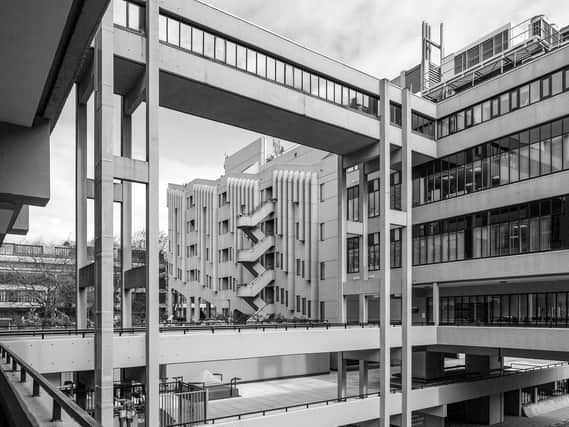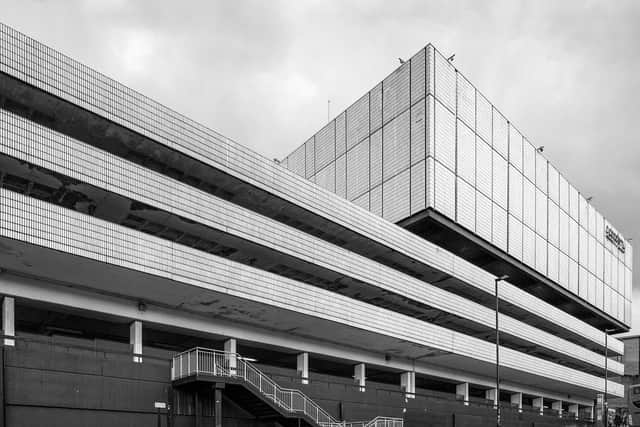A new book explores the story of Brutalist architecture in the North


These post-war modernist buildings, many of which were attached to the Brutalist style of design, are characterised by their reliance on utilitarian concrete, steel and glass – all clean lines and geometric shapes, the structures put the focus on each place’s primary function and were a world away from the ornate edifices of the Victorian era.
The Bank of England building in Leeds – a fortress-like structure on King Street that is a centrepiece of the city’s financial district – Huddersfield’s Queensgate Market with its innovative roof and striking ceramic mural, and Sheffield’s monolithic Park Hill estate are among those that are listed for their heritage value. All three, plus 42 other buildings across the region, are included in a new book of images by photographer Simon Phipps that is billed as the most extensive survey of its kind.
Advertisement
Hide AdAdvertisement
Hide AdBrutal North is the result of years of work by Phipps, and while its scope encompasses Northern England as a whole, Yorkshire towns and cities loom large, making up more than a third of the volume’s content.


“I’m very pleased to see it in print, it was a bit of a struggle to get there this year,” says Phipps, who had to navigate the worsening pandemic
and lockdown to finish the project with his publisher.
“There was no travel, and I didn’t have all the photography completed. As things eased up I had to try and fit it in, travelling round the near-empty motorways of the North.
“It was quite odd – just the feeling of being one of the only people out there. It was quite a barren time. Normally I rely on my own patience to allow people to clear out of the scene, pretty much all of my photographs are unpopulated, they’re really about the architecture.”


Advertisement
Hide AdAdvertisement
Hide AdEach building in Brutal North is shot in stark monochrome and comes with a detailed listing explaining its origins. The citations highlight the fact that many of these schemes were instigated by local authorities for civic purposes from the 1950s onwards – Phipps says this was a response to the ‘devastation’ wrought by Second World War bombs.
“There were obviously a lot of commissioning bodies, mostly councils, who were really grasping the nettle and taking on the need to create mass housing and civic buildings,” he says. “I think it was taken very seriously, particularly in Sheffield.
"The city architects’ department under John Lewis Womersley commissioned massive amounts of building that’s still very much in evidence today such as Park Hill and Gleadless Valley. I certainly think they’ve lasted the test of time. I’ve selected buildings that have a fairly reasonable profile but also unknown buildings, and fairly neglected ones that might be a surprise for people to discover.”
The word ‘brutalism’ comes from the French béton-brut, literally meaning ‘raw concrete’ – this was a term used by Swiss-French architect Le Corbusier to explain his methods at the enormous Unité d’Habitation housing complex in Marseilles, France, completed in 1952. Reyner Banham, the British architectural critic, later wrote an essay called The New Brutalism, in 1955, which popularised the style, and in his foreword Phipps reflects on the movement’s links to socialist ideals.
Advertisement
Hide AdAdvertisement
Hide Ad“Looking at the small list of achievements credited to the Northern Powerhouse since it was formed in 2015, it pales into insignificance in comparison to the north of the post-war years and the determination of its civic convictions and drive to create a proud and better society for all,” he writes.
Park Hill was designed by Jack Lynn, Ivor Smith and Frederick Nicklin; built between 1958 and 1961 as an experiment in social housing, its famous ‘streets in the sky’ were wide enough to accommodate a milk float. Today the vast estate is undergoing a lengthy revamp, mostly with the aim of creating new apartments, of which only a limited proportion will be classed as ‘affordable housing’.
“The vision of the welfare state has been somewhat diminished in recent decades by the Right to Buy policy, which started to erode this vision of public housing of which Park Hill was an exemplar,” says Phipps. “I found it quite sad that this ambition that local government had has been crushed, and we’re now reliant on private developers to bail out a lot of these schemes.”
Park Hill, which had declined by the 1980s and gained a reputation as a crime hotspot, escaped the threat of demolition when it became Europe’s largest listed building in 1998, the year it was given Grade II* status.
Advertisement
Hide AdAdvertisement
Hide AdSimilarly, the landmark Kingston House in Hull – designed by the renowned practice of Fry, Drew and Partners as the offices of Humberside County Council – was labelled an eyesore and faced being knocked down; instead it was refurbished between 2017 and 2018 to become the K2 development, containing offices and apartments.
Does Phipps sympathise with those for whom Brutalism doesn’t appeal?
“Not really, no,” he says, laughing. “There’s many periods of architecture I don’t have a great liking for but to demolish it, for aesthetic dislike, is ridiculous. Cities are built up as a tapestry of historic styles – if you don’t have that contrast, you lose something. The cityscape is built up through historical progress. From my point of view it’s always good to retain what has value – that goes from the Victorian period up to now.”
Some places are gone forever though, such as the sprawling Yorkshire Post building on Wellington Street; this was designed by the John Madin Group and opened by Prince Charles in 1970, but was demolished in 2014.
Advertisement
Hide AdAdvertisement
Hide Ad“It’s extraordinary how much stuff was created during this period, how many huge schemes were put into operation and developed, and then demolished 30 years later,” says Phipps. “I think Leeds suffered from a bit of that.”
Phipps was born in Leeds, but grew up in the South and studied sculpture at the Royal College of Art. His parents were both architects who worked at the Milton Keynes Development Corporation as the ambitious new city was being designed.
“I recall being taken on journeys to visit buildings I had absolutely no interest in at the time, but obviously something rubbed off over the years because the imagery kept coming back to me,” he says. “It evolved into what I do now, really. I spent a good deal of my time during holidays up in the North, my family is from Castleford so we used to go on holiday to Scarborough quite a lot which I have very fond memories of.”
He enjoyed returning to Leeds for Brutal North, which follows on from his previous books Brutal London and Concrete Poetry.
Advertisement
Hide AdAdvertisement
Hide Ad“The stand-out, for me, is the Leeds University campus – the extension by Chamberlin, Powell and Bon,” he says. “That is absolutely superb. Bank House is extraordinary, and I have a liking for the red-brick court building down by the Town Hall.”
Phipps also took the opportunity to capture the expansiveness of the breathtaking Humber Bridge, which appears as a later work of modernism praised by Historic England for its ‘taut, pared-down elegance’.
“It’s stunning,” he says. “Standing underneath it is incredible. The diminishing view of it crossing the Humber until it’s this thin slender line... there’s a contrast between its strength and beauty, really.”
Having produced three titles on the subject, does Phipps feel he’s exhausted the topic?
Advertisement
Hide AdAdvertisement
Hide Ad“No, I’ll be back for more,” he says decisively. “There’s plenty, if not in this country but certainly worldwide. I’m quite keen to do something on Scotland some time in the near future, there’s a lot of strong architecture up there that I’d love to compile into another volume.”
Brutal North, published by September, is out now priced £16.99 in hardback. See www.simonphipps.co.uk for further details.